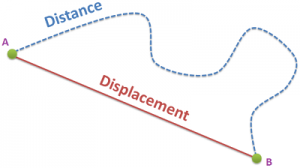Displacement and Distance
In Physics, we have to be able to find the motion or movement of the object. Where Object might be small or big. One of the important way to describe the motion of an object is HOW FAR THE ONJECT MOVED? This can be described by either of these two:
Distance and Displacement. So, what is displacement? And what is Distance?
What is Distance?
Distance is the total length of path traversed by the moving body without worrying about direction.
What is Displacement?
Displacement is the length of the straight line between the initial position of the object before movement (or motion) and final position of the object after movement with the direction.
Difference between Distance and Displacement:

Distance and Displacement are used to indicate the length between two points. However, these two are not one and the same thing. While distance is the length of the actual path between two locations, displacement, on the other hand, is the length of the shortest path between two locations.
So, the distance is, how much path is travelled by the body during motion and the displacement gives an idea of how far the body is from its starting point and in which direction.
How to find the Displacement?
Problem: A person travels 250 miles to North but then back-tracks to South for 105 miles to pick up a friend. What is the person total displacement?
Solution: Person starting position, xᵢ = 0.
Her final position xf is the distance travelled North distance minus the South distance.
Displacement (D) = Δx = (xf – xᵢ)
Displacement (D) = Δx = ([250 miles in North – 105 miles in South] – 0)
Displacement (D) = 145 miles in North.
How to find the Distance?
Problem: An object moves from point A to point B to point C, then back to point B and then to point C along the line shown in the figure below.
![]()
Find the distance covered by the moving object?
Solution: Distance = AB + BC + CB + BC = 5 + 4 + 4 + 4 = 17 km.
